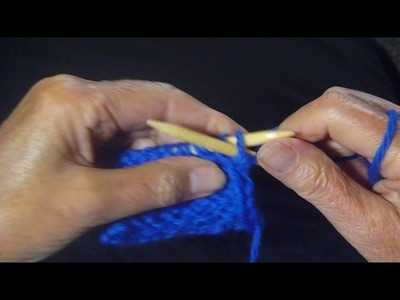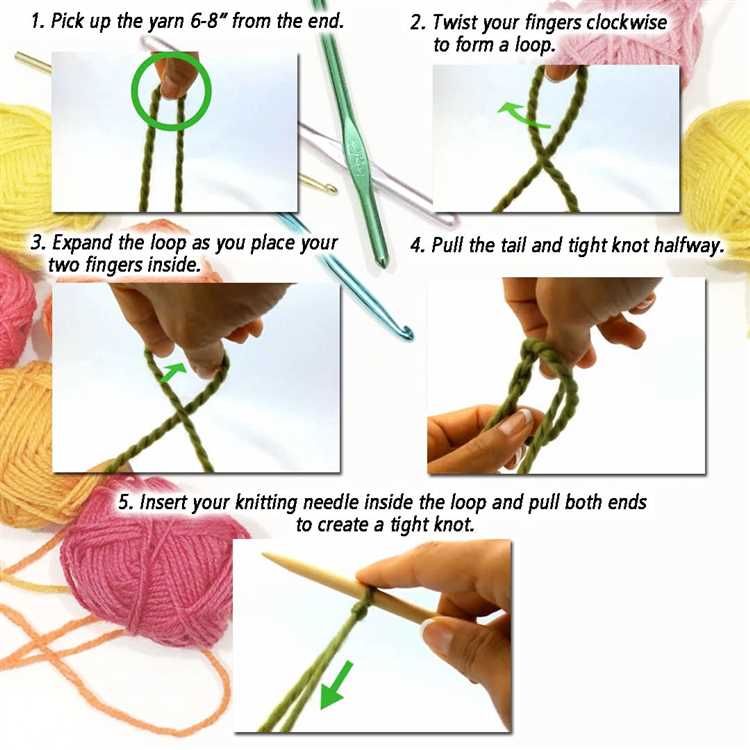Knitting is a craft that has been around for centuries, and one of the first things every beginner learns is how to create a slip knot. This simple loop of yarn is used to start almost every knitting project, but does it actually count as a stitch?
The answer to this question is both yes and no. In traditional knitting patterns, the slip knot is not considered a stitch and is not included in the stitch count. However, it is an important part of the knitting process and is used to create the first stitch on the needle.
While the slip knot itself doesn’t count as a stitch, it does play a crucial role in determining how many stitches are in a row. When counting stitches in knitting, you typically start by counting the first loop on the needle as stitch number one. This means that the slip knot does indirectly affect the stitch count.
So, while the slip knot itself doesn’t count as a stitch, it is still an essential part of knitting and is used to create the first stitch. Whether or not it is included in the stitch count depends on the specific pattern and the preferences of the knitter.
Ultimately, the slip knot may or may not be counted as a stitch in knitting, but it is undoubtedly a fundamental element in starting a project. Understanding the role of the slip knot and how it relates to stitch counting will help you navigate knitting patterns with confidence and create beautiful, well-constructed pieces.
Understanding the Slip Knot
The slip knot is a essential technique in knitting, used to start a project or create a new stitch.
A slip knot is formed by creating a loop with your yarn and pulling one end of the loop through, creating a knot. This loop is placed on your knitting needle and counts as the first stitch of your project.
The slip knot is typically used to cast on stitches but can also be used when increasing or decreasing stitches, or when joining a new ball of yarn.
When creating a slip knot, it is important to ensure that it is not too tight or too loose. A knot that is too tight can make it difficult to insert your knitting needle into the loop, while a knot that is too loose can result in loose and uneven stitches.
Here is a step-by-step guide on how to create a slip knot:
- Hold the end of your yarn in your hand, leaving a long tail.
- Create a loop with the yarn, crossing the tail over the working yarn.
- Insert your hand through the loop, grabbing the working yarn.
- Pull the working yarn through the loop, creating a knot.
- Place the slip knot on your knitting needle.
- Tighten the slip knot by pulling on the tail and working yarn, ensuring it is secure but not too tight.
Once you have your slip knot on your needle, you can begin knitting your project. It is important to remember that the slip knot counts as the first stitch, so you will need to take this into account when following a pattern or counting your stitches.
By understanding and mastering the slip knot technique, you will have a solid foundation for your knitting projects and be able to confidently start and create new stitches.
Determining Knitting Stitches
When knitting, it is important to accurately determine the number of stitches in your work. This helps ensure that your project turns out the correct size and shape.
There are a few different ways to determine the number of stitches in your knitting:
- Counting the visible loops or bumps on the needle: This method involves physically counting each loop or bump on your needle. It can be a bit tedious, especially for larger projects, but it is a reliable way to get an accurate stitch count.
- Using stitch markers: Stitch markers are small rings or clips that can be placed on your needle at specific intervals. By placing a stitch marker after a certain number of stitches, you can easily keep track of your stitch count as you work.
- Using a row counter: A row counter is a small device that can be attached to your knitting needle or wrist. It allows you to keep track of the number of rows and stitches you have worked.
It is also important to note that the slip knot, which is used to begin most knitting projects, does not count as a stitch. The slip knot is used to secure the first stitch on your needle, but it is not considered a part of the actual stitch count.
| Abbreviation | Description |
|---|---|
| sts | Stitches |
| rs | Right side |
| ws | Wrong side |
By accurately determining your knitting stitch count, you can ensure that your projects turn out as intended and avoid any unexpected surprises.
Knitting Patterns and the Slip Knot
When it comes to knitting, the slip knot is an essential technique used to begin many patterns. While it may not technically be considered a stitch, it is the first step in creating a new loop on your knitting needle, which is then used to create the first actual stitch. Understanding how to properly create and use a slip knot is crucial for success in knitting.
A slip knot is a loop that can easily be adjusted in size and is used to secure the yarn to the knitting needle. It is typically made using a simple technique that involves creating a loop and pulling the working end of the yarn through the loop. This loop can then be tightened or loosened as needed.
In knitting patterns, the slip knot is often the starting point for casting on stitches. It is used to create the first loop, which is then used to cast on additional stitches. Some patterns may specify a specific method for creating the slip knot, while others may leave it up to the knitter’s preference.
It’s important to note that the slip knot does not count as a stitch in knitting. It is simply a way to secure the yarn and create the first loop on the needle. The first actual stitch is created by working into this loop, often through a process called knitting or purling.
When following a pattern, be sure to read the instructions carefully to understand how the slip knot should be used. It may specify whether the slip knot should be included in the final stitch count or if it should be worked separately.
To summarize, while the slip knot is an important technique in knitting, it is not considered a stitch. It is the first step in creating a loop on the needle and is used to start many knitting patterns. Understanding how to properly create and use a slip knot is essential for success in your knitting projects.
Counting Stitches in Knitting
Counting stitches is an essential skill in knitting. It allows you to keep track of your progress, ensure accuracy in pattern repeats, and troubleshoot any mistakes. Here are some important points to keep in mind when counting stitches:
- Every loop counts as a stitch: In knitting, every loop on your needle counts as a stitch. This includes the loops from the previous row, as well as any additional loops created during the current row.
- Consider the slip knot: The slip knot, which is used to start most knitting projects, does not count as a stitch. It serves as a placeholder and is usually removed after completing the first row.
- Start counting from the first visible stitch: When counting stitches, it’s best to start from the first visible stitch on your needle. This is usually the stitch closest to the tip of the needle. Count each loop as you move along the row.
- Keep track of pattern repeats: If you’re following a pattern that includes repeating sections, it’s important to keep track of the number of stitches in each repeat. This will help you maintain the correct stitch count and ensure that your project looks as intended.
- Use stitch markers: To make counting stitches easier, especially when working on complex patterns, it’s helpful to use stitch markers. These small rings or clips can be placed on the needle to mark specific stitches or pattern repeats.
Counting stitches is an essential skill that every knitter should master. It allows you to follow patterns accurately and create beautiful, well-fitting projects. With practice, counting stitches will become second nature, and you’ll be able to confidently tackle any knitting project.
The Slip Knot as the First Stitch
When starting a knitting project, the slip knot is often used as the first stitch. While some may argue that the slip knot does not count as a stitch, it is important to understand its purpose and how it functions in knitting.
The slip knot is commonly used as the first stitch because it provides a stable and secure foundation for the project. It allows for easy insertion of the knitting needle and prevents unraveling of the yarn.
Although the slip knot is typically not counted as a stitch in the final count, it is still an essential component of the knitting process. Without the slip knot, it would be challenging to begin the project and create a neat and tidy edge.
One of the advantages of using a slip knot as the first stitch is that it can easily be tightened or loosened as needed. This flexibility allows for adjustments in tension and ensures that the first row or round of stitches is consistent with the rest of the project.
Another benefit of starting with a slip knot is that it creates a consistent loop that can be easily identified and worked into subsequent stitches. This loop serves as a reference point and helps maintain a uniform tension throughout the project.
It is important to note that the slip knot should be fairly loose to accommodate the movement of the needle and yarn. If it is too tight, it can be difficult to insert the needle and manipulate the stitches.
In conclusion, while the slip knot may not be considered a true stitch in knitting, it plays a crucial role in establishing the foundation of a project. It provides stability, ease of use, and creates a consistent loop for subsequent stitches. So, next time you start a knitting project, don’t forget the importance of the slip knot as the first stitch!
Alternative Methods to Begin Knitting
While the slip knot is a popular choice for starting a knitting project, there are also alternative methods that can be used. Here are a few options:
Long Tail Cast On
The long tail cast on is a versatile and commonly used method to start a knitting project. It creates a neat, elastic edge that is perfect for most projects.
How to do the long tail cast on:
- Make a slip knot and place it on the knitting needle.
- Hold the yarn in your left hand, with the tail end over your thumb and the working yarn over your index finger.
- Insert the needle between your thumb and index finger, going under the thumb yarn and over the index finger yarn.
- Bring the needle up and over the thumb yarn, creating a loop.
- Slide the loop onto the needle, and pull the working yarn tight.
- Repeat steps 3-5 until you have cast on the desired number of stitches.
Knitted Cast On
The knitted cast on is another commonly used method that creates a neat, firm edge. It is a good choice for projects where you want a sturdy and stable start.
How to do the knitted cast on:
- Make a slip knot and place it on the knitting needle.
- Insert the right needle into the slip knot as if to knit.
- Make a knit stitch by wrapping the working yarn around the right needle from back to front and pulling it through the slip knot.
- Transfer the new stitch from the right needle to the left needle.
- Repeat steps 2-4 until you have cast on the desired number of stitches.
Cable Cast On
The cable cast on creates a neat, firm edge and is often used when you need to add stitches in the middle of a row or for buttonholes.
How to do the cable cast on:
- Make a slip knot and place it on the knitting needle.
- Hold the knitting needle with the slip knot in your right hand.
- Insert the left needle between the first and second stitches on the right needle, going from front to back.
- Wrap the working yarn around the left needle in a counter-clockwise direction.
- Bring the loop of yarn through the gap between the first and second stitches, and place it on the left needle.
- Repeat steps 3-5 until you have cast on the desired number of stitches.
These alternative methods to begin knitting offer different outcomes and are suitable for different projects. Experiment with each method to find the one that suits your knitting style and project needs.
Pros and Cons of Using the Slip Knot
The slip knot is a commonly used technique in knitting that is used to create the first stitch on the needle. While it is a popular method, it does have its advantages and disadvantages. Here are some pros and cons of using the slip knot:
-
Pros:
- Easy to create: The slip knot is relatively easy to create, especially for beginners. It only requires a few simple steps and can be quickly mastered.
- Secure: The slip knot creates a secure foundation for the rest of the stitches. It ensures that your stitches won’t unravel or come undone while you are knitting.
- Versatile: The slip knot can be used for various knitting projects. It is commonly used to start a new row or join yarn, but can also be used for decorative purposes.
- Uniformity: Using the slip knot consistently throughout your project helps to maintain a uniform tension and appearance.
-
Cons:
- Creates an extra stitch: When you use the slip knot, it counts as a stitch on your needle. This can be a disadvantage if you are trying to knit a specific number of stitches and need to subtract the slip knot from your count.
- Can be tight: When creating the slip knot, it’s important to ensure that it is not too tight. A tight slip knot can make it difficult to insert the needle and work the subsequent stitches.
- Requires extra yarn: The slip knot requires a small amount of yarn to create, which may result in wasting yarn if you need to undo and rework your project.
Overall, the slip knot is a useful technique in knitting that has its pros and cons. It is important to consider these factors and determine if the slip knot is the best method for your specific project.
FAQ:
What is a slip knot in knitting?
A slip knot is the first step in starting a knitting project. It is a loop that is used to secure the yarn on the needle.
Does the slip knot count as a stitch in knitting?
No, the slip knot does not count as a stitch in knitting. It is only used to secure the yarn on the needle.
Why is the slip knot not considered a stitch in knitting?
The slip knot is not considered a stitch because it is not part of the fabric of the knitted piece. It is simply a loop that secures the yarn.
Can I skip the slip knot when starting a knitting project?
No, you cannot skip the slip knot when starting a knitting project. It is an essential step to secure the yarn on the needle and is necessary for proper tension and tension control.


